The global vitamin B3 market size is calculated at USD 394.83 million in 2025 and is forecasted to reach around USD 481.52 million by 2034, accelerating at a CAGR of 2.23% from 2025 to 2034. The Asia Pacific market size surpassed USD 146.76 million in 2024 and is expanding at a CAGR of 2.36% during the forecast period. The market sizing and forecasts are revenue-based (USD Million/Billion), with 2024 as the base year.
The global vitamin B3 market size accounted for USD 386.22 million in 2024 and is expected to exceed USD 481.52 million by 2034, growing at a CAGR of 2.23% from 2025 to 2034. The increased demand for nicotinic acid in condition treatment solutions is driving the growth of the global vitamin B3 market. The growing adoption of vitamin B3 to treat cardiovascular disease is projected to further enhance the market in the upcoming period.
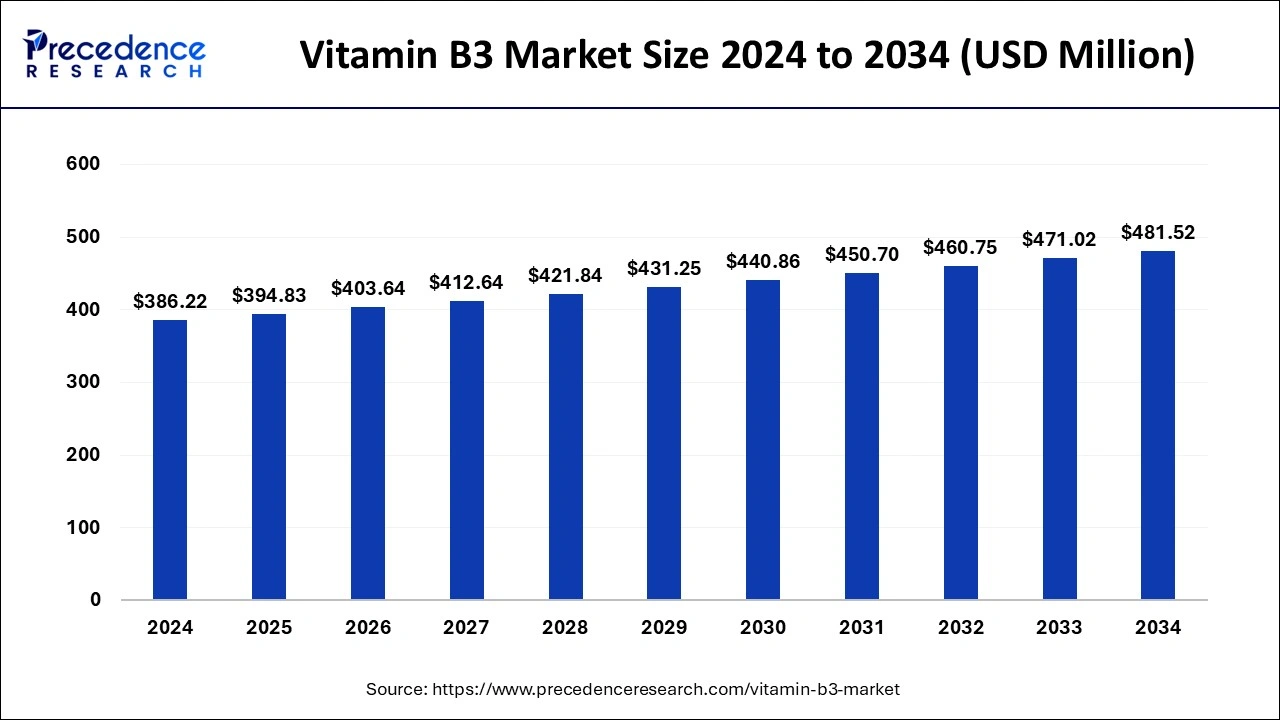
The vitamin B3 market has gained popularity due to several factors like rising awareness of health & wellness, animal health, and skin health. The demands for dietary supplements, animal feeds, and s are driving the market growth. The increased demands are leading to further innovation and manufacturing of nicotinic acid-based products. This spectacular demand has been seeking the essential, effective, and modern tools to boost the manufacturing volume. Artificial Intelligence tools are helping to improve the formulation range of vitamin B3.
AI-driven predictive maintenance, quality control, and process optimization are significant in improving manufacturing capabilities and cost-effectiveness. AI not only helps to improve safety and efficacy but is also helpful in overcoming one dosage-related limitation of vitamin B3. AI-powered algorithms help to demonstrate the need for sufficient dosage, which further reduces the risk of side effects. The rising utilization of AI in manufacturing and supply chain is leading the vitamin B3 market toward further success.
The Asia Pacific vitamin B3 market size was exhibited at USD 146.76 million in 2024 and is projected to be worth around USD 185.39 million by 2034, growing at a CAGR of 2.36% from 2025 to 2034.
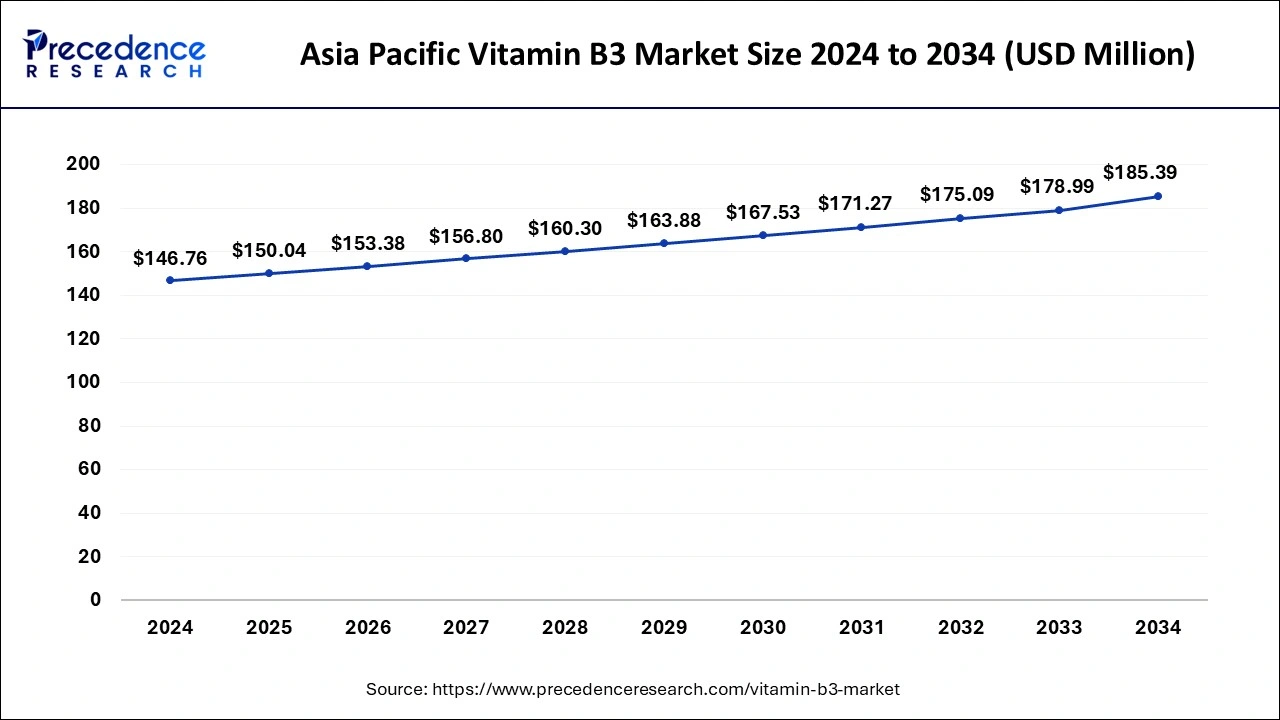
Asia Pacific dominated the vitamin B3 market with the largest share in 2024. This is mainly due to the significant increase in the adoption of health and dietary supplements. China is leading the regional market due to increased awareness of the health benefits of vitamin B3 in preventing cardiovascular disease and reducing cholesterol levels.
The increased usage of vitamin B3 in cosmetics products further bolstered the market in China. Additionally, government initiatives and support to promote traditional Chinese medicines contribute to market expansion. India is the second-largest leader in the Asian vitamin B3 market. This is mainly due to the rapid expansion of the cosmetic & skin care industry, rising consumer awareness about the benefits of vitamin B3, and rising demand for fortified food in India.
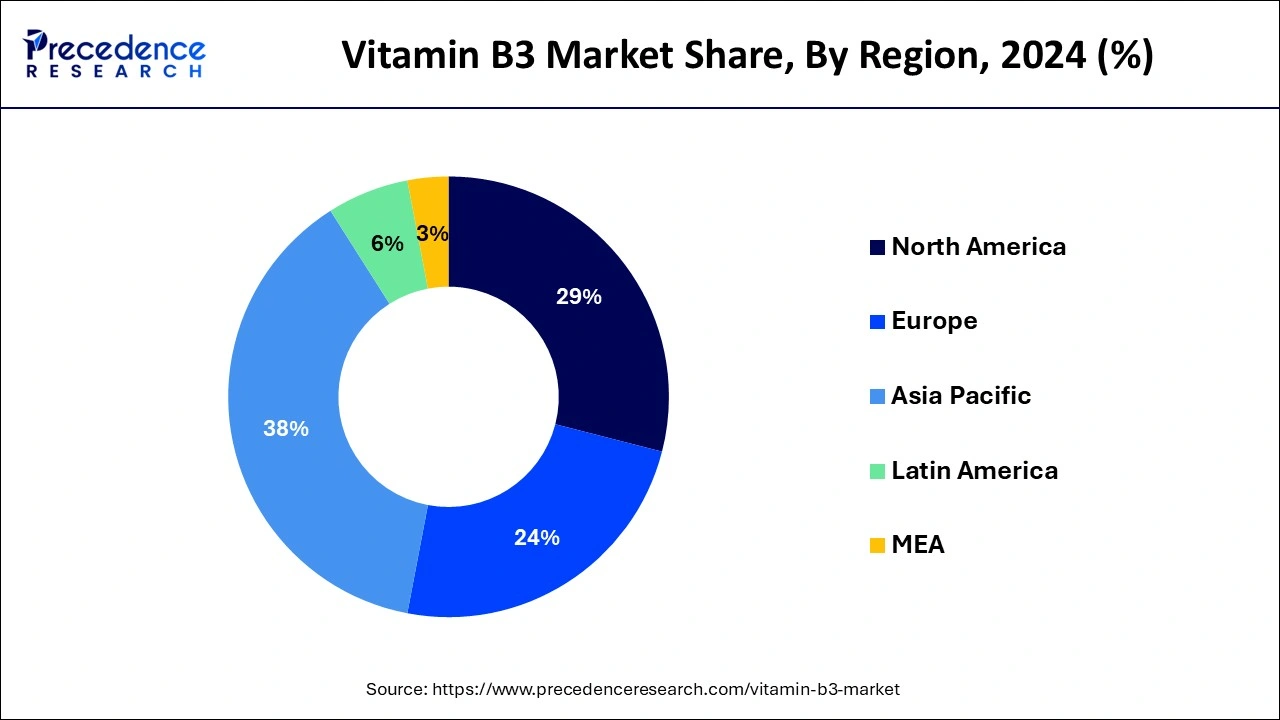
North America is projected to expand at the highest CAGR in the coming years. With the increasing awareness among people about health and wellness, there is a high demand for nutritional supplements, which contributes to regional market growth. The rising prevalence of hyperlipidemia and cardiovascular disease is further boosting the adoption of vitamin B3, as it is ideal for lowering cholesterol and the risk of certain types of heart disease.
The U.S. is leading the regional market due to the presence of large and well-established pharmaceutical companies in the country. Additionally, the rising consumer preference for vitamin B3 in cosmetic products is driving its adoption in cosmetic and beauty products. The rising consumer awareness for effective skincare is also boosting the adoption of vitamin B3 in the cosmetic industry in the U.S. Canada is the second largest country, leading the regional market due to the rising prevalence of hyperlipidemia in the country.
Nicotinic acid is also popularly known as vitamin B3 and niacin, which is significantly used to treat cardiovascular disease and hyperlipidemia. The changing lifestyles are leading to the prevalence of obesity and cardiovascular disease. Nicotinic acid is well known for its ability to improve skin health, and its utilization in cosmetics, skincare, and personal care products has increased.
Factors like growing awareness of health & wellness are the significant drivers of the global vitamin B3 market. The demand for dietary supplements, foods, and energetic drinks is emerging in the vitamin B3 market. Moreover, the growing awareness of animal health is also anticipating market expansion. The utilization of niacin in animal feeds has increased to boost their metabolism, nutrition, protein volume, and growth rate and to reduce skin disease among animals.
The ongoing research and development in pharmaceuticals are helping to find novel ways to treat cardiovascular disease. The government and pharmaceutical companies have surged in investment to boost the R&D sector and overcome the prevalence of cardiovascular and hyperlipidemia. The rising awareness of the advantages of nicotinic acid in the nerves and digestive systems is emerging in the market. The rising concern of niacin deficiency has been transforming the market in recent years.
| Report Coverage | Details |
| Market Size by 2024 | USD 386.22 Million |
| Market Size in 2025 | USD 394.83 Million |
| Market Size in 2034 | USD 481.52 Million |
| Market Growth Rate from 2025 to 2034 | CAGR of 2.23% |
| Dominating Region | Asia Pacific |
| Fastest Growing Region | North America |
| Base Year | 2024 |
| Forecast Period | 2025 to 2034 |
| Segments Covered | Source, Form, Application, and Regions |
| Regions Covered | North America, Europe, Asia-Pacific, Latin America, and Middle East & Africa |
Expanding cosmetic industry
The demand for vitamin B3 has increased in cosmetic and personal care products due to its anti-aging properties. Nicotinic acids work to reduce wrinkles and improve brightness and a more even tone of the skin. The benefits of nicotinic acid in reducing inflammation and skin irritations have further enhanced its adoption in skincare and cosmetic products. Nicotinic acid also helps to hydrate the skin.
The utilization of nicotinic acid in creams, serums, and face masks has increased, which is leading to growth in the market. Additionally, a growing trend toward organic skin care products holds opportunities for market growth. The ongoing research and development for enhancing the efficacy and safety of nicotinic acid in cosmetic applications is fuelling the market expansion.
High dosage
The high dose of vitamin B3 is risky for animal, human, and environmental impacts. The high doses of nicotinic acid can cause flushing, itching, and gastrointestinal challenges, which can also cause risk of toxicity, including liver damage, and cause inflammations & bleeding. Such limitations can impact the adoption rate of nicotinic acids. However, ongoing innovations in formulations can help to reduce side effects and improve the bioavailability of nicotinic acids.
Growing awareness about animal nutrition
Nicotinic acids help to boost the immune system and feed efficiency. Nicotinic acid is majorly used in animal nutrition supplements to improve energy metabolism and support growth and development in animals. In poultry feeds, the adoption rate of vitamin B3 has increased to improve growth rate, egg production, and feed efficiency. Similarly, vitamin B3 is being used in swine feeds to reduce mortality and improve animal health. The demand for vitamin B3 has surged to high in aquaculture to improve feed efficiency and reduce disease. The growing utilization of nicotinic acid in pet food to improve skin and health is emerging in the market. With rising awareness of animal health, nutrition balance, and animal protein, the innovation and developments in nicotinic acid are expected to surge.
The natural segment dominated the global vitamin B3 market in 2024. The segment growth is attributed to increased awareness of natural & organic products. The growing demand for organic cosmetics, skin care products, and nutritional supplements is high. The rising awareness of health & wellness has driven consumer preference toward the adoption of nicotinic acid-based supplements and products.
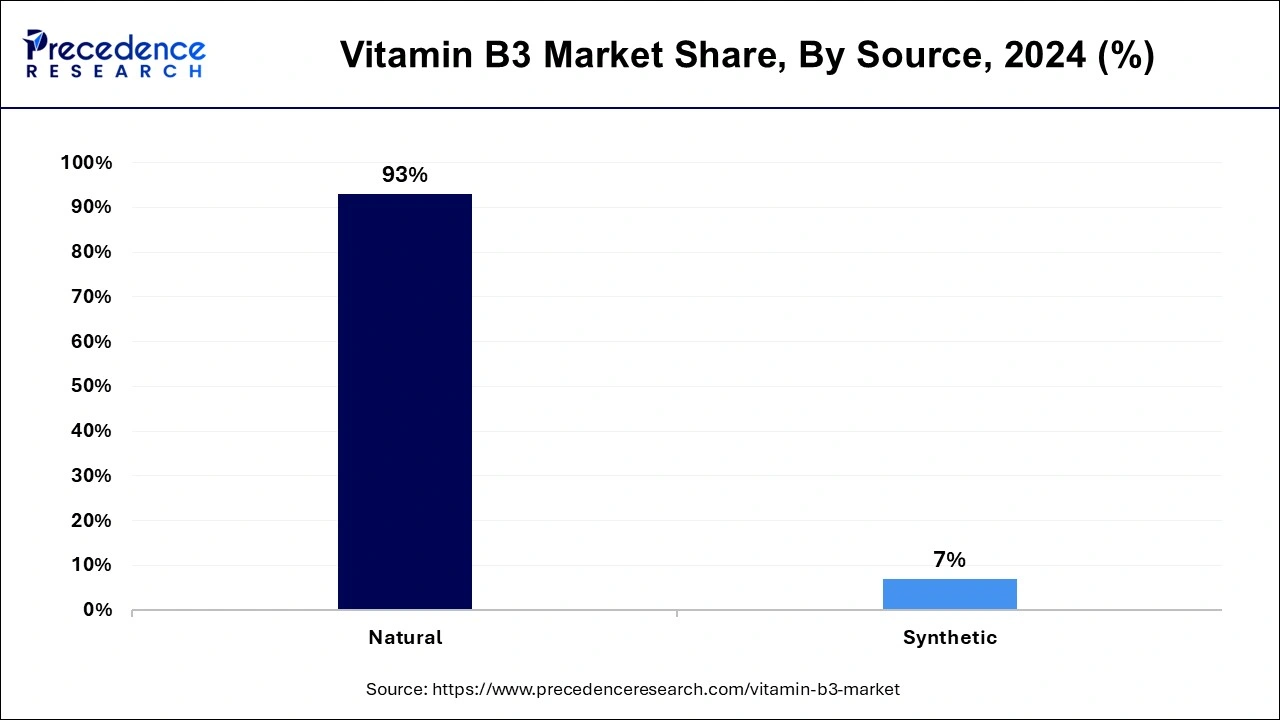
On the other hand, the synthetic segment is anticipated to witness spectacular growth in the forecast period due to rising demand for scalable and affordable supplements. Synthetic vitamin B3 are consistent in quality and purity. The rising utilization of nicotinic acids in animal feeds, cosmetic products, and pharmaceutical products are the factors driving the growth of the segment.
The dry segment generated the largest share of the market due to its characteristic of improving metabolic functions. Dry nicotinic acids are more stable compared to liquid ones. Moreover, they provide high purity and are easier to handle, store, and transport, which helps to reduce overall logistics expenses. The increased demand for nicotinic acids in pharmaceuticals for the treatment of cardiovascular disease and hyperlipidemia is driving the adoption of dry nicotinic acids. Additionally, increased demand for supplements is also contributing to the segment expansion.
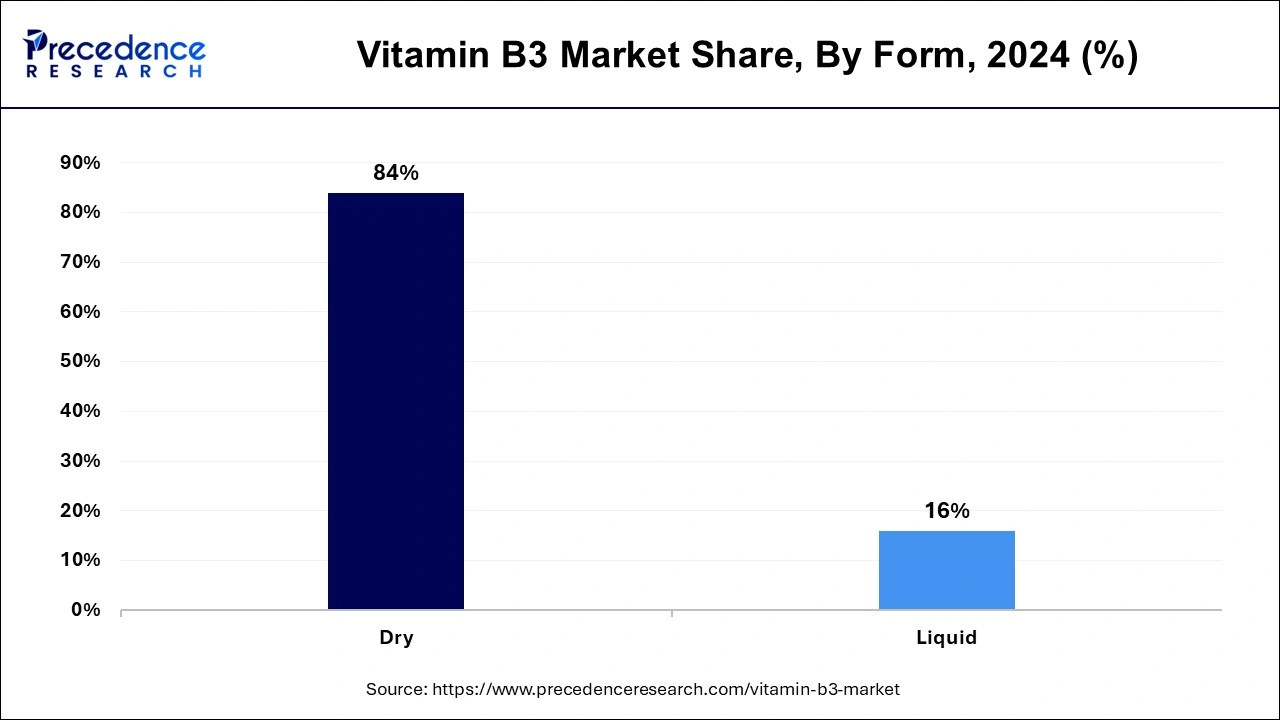
On the other hand, the liquid segment accounted for the fastest-growing segment of the market. The segment growth is anticipated to be majorly due to the increased utilization of vitamin B3 in beverages to stimulate energy. Liquid nicotinic acids are convenient and bioavailable compared to the tablet and powder (dry) forms. Moreover, the rising utilization of niacin in cosmetic products, including serums and face masks.
The animal feed segment led the market in 2024 due to rising awareness of animal health and their nutritional volume. The utilization of vitamin B3 has surged for high-rate animal feeds to improve growth rate and treat skin-related diseases. Nicotinic acids help to reduce inflammations and improve metabolisms. The increased consumer demand for more nutritionist, protein-included animal foods is driven by the utilization of nicotinic acid in animal feeds. Additionally, the advancements in farming practices are supporting the segment's growth.
However, the cosmetics segment is expected to lead the market in the forecast period due to increased demand for organic, natural cosmetic products. The utilization of nicotinic acids has increased in cosmetic and personal care products due to growing awareness of their benefits for the skin. The aging-gaining properties of vitamin B3 are making them popular among skin-conscious people. The demand for skin-brightening and elastic products has increased the adoption of nicotinic acids in cosmetic products. Additionally, ongoing innovation & developments of cosmetic products according to individual skin types and preferences are projected to enhance segment growth.
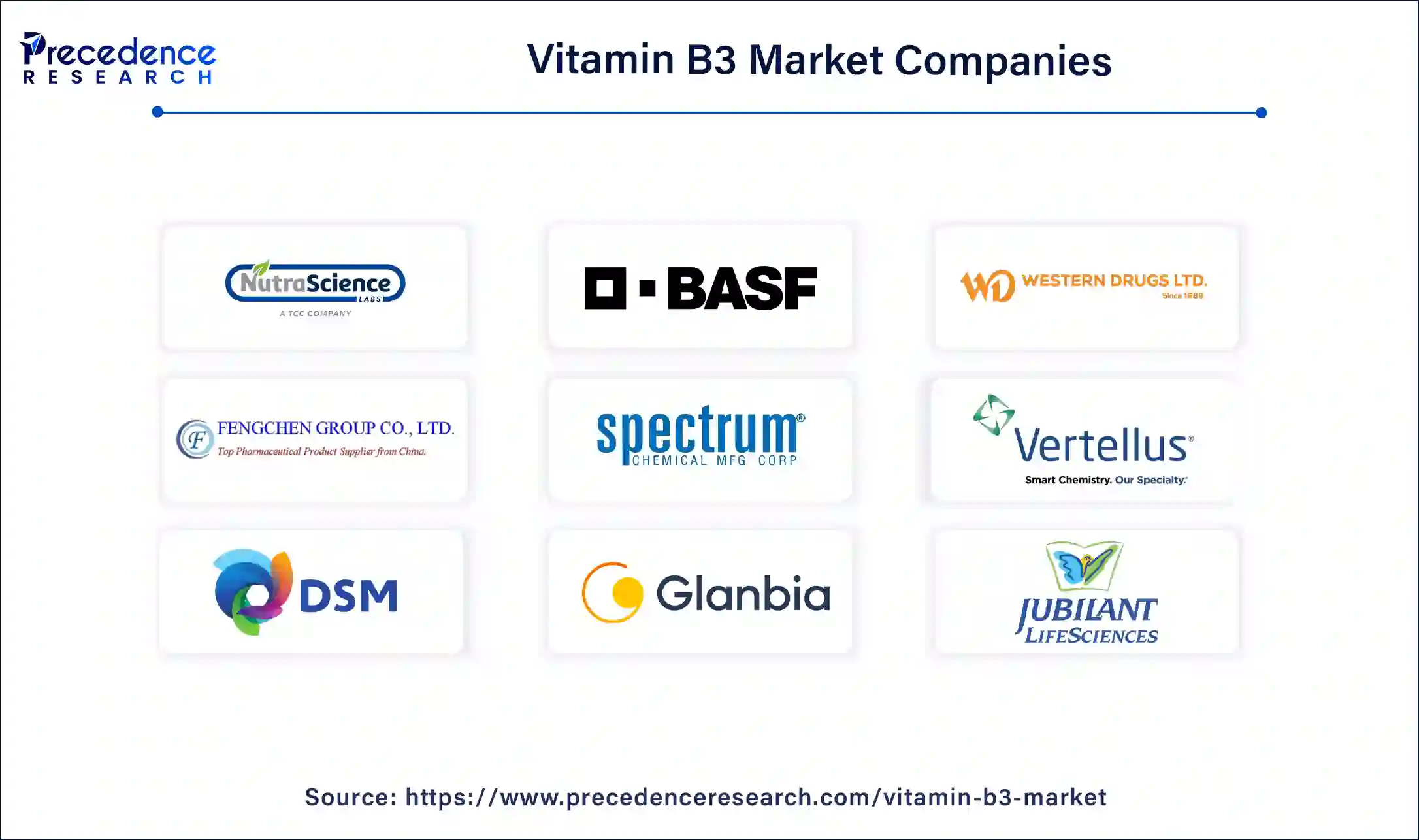
By Source
By Form
By Application
By Geography
For inquiries regarding discounts, bulk purchases, or customization requests, please contact us at sales@precedenceresearch.com
No cookie-cutter, only authentic analysis – take the 1st step to become a Precedence Research client